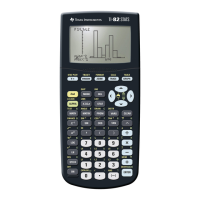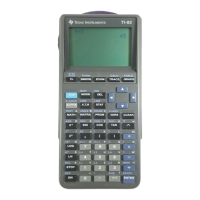Programming 16–5
82E978~1.DOC TI-83 international English Bob Fedorisko Revised: 10/26/05 1:47 PM Printed: 10/27/05 3:02
PM Page 5 of 22
You can enter on a command line any instruction or expression
that you could execute from the home screen. In the program
editor, each new command line begins with a colon. To enter more
than one instruction or expression on a single command line,
separate each with a colon.
Note: A command line can be longer than the screen is wide;
long command lines wrap to the next screen line.
While in the program editor, you can display and select from
menus. You can return to the program editor from a menu in
either of two ways.
• Select a menu item, which pastes the item to the current
command line.
• Press ‘.
When you complete a command line, press Í. The cursor
moves to the next command line.
Programs can access variables, lists, matrices, and strings saved
in memory. If a program stores a new value to a variable, list,
matrix, or string, the program changes the value in memory
during execution.
You can call another program as a subroutine (page 16.15 and
page 16.22).
To execute a program, begin on a blank line on the home screen
and follow these steps.
1. Press to display the
PRGM EXEC menu.
2. Select a program name from the PRGM EXEC menu (page
16.7).
prgmname is pasted to the home screen (for example,
prgmCYLINDER).
3. Press Í to execute the program. While the program is
executing, the busy indicator is on.
Last Answer (
Ans) is updated during program execution. Last
Entry is not updated as each command is executed (Chapter 1).
The TI-82 STATS checks for errors during program execution.
It does not check for errors as you enter a program.
To stop program execution, press É. The
ERR:BREAK menu is
displayed.
• To return to the home screen, select 1:Quit.
• To go where the interruption occurred, select
2:Goto.
Entering Command Lines and Executing Programs
Entering a
Program
Command Line
Executing a
Program
Breaking a
Program

